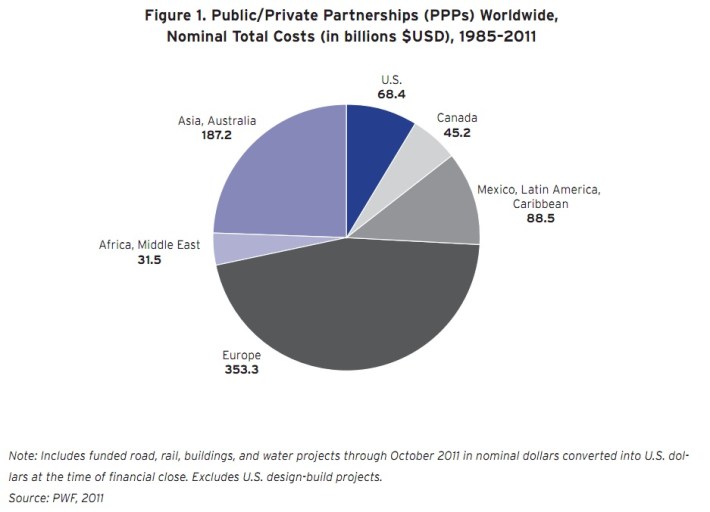
When government types start to talk about expanding infrastructure, you’re likely to hear the phrase “public-private partnership” thrown around a lot. PPPs (or P3s, or 3Ps) are one of the “innovative financing tools” that policymakers love to hold up as a way to expedite expensive infrastructure projects that taxpayers want but aren’t willing to pay for – or that elected officials want to build but won’t take any political risks to support.
In one form of PPP, the government bundles several responsibilities -- like the design, financing, construction, and maintenance of new infrastructure -- into a single contract, and bids it out to a private company. Essentially, the company provides the infrastructure, and the government pays that company a service fee for each year of the contract, plus interest to repay construction costs.
When successful, a PPP lets government get more bang for its buck, but there are other kinds of PPP, too. One of those other variations, which some experts wouldn't even consider a "true" PPP, involves taking some piece of publicly-built-and-paid-for infrastructure and leasing it out to a private company. Chicago did this with their parking system in 2008, and got burned, receiving far less from the contractor than the value of the meters would dictate. The main function of the PPP, in this case, was to "outsource to political will" to raise the price of on-street parking.
America is somewhat late to the table when it comes to PPPs, though the idea is gaining traction -- and attracting criticism. While some, including President Obama, hope that PPPs are the ticket to infrastructure expansion in a public-spending-averse political climate, others see it as the kind of crony capitalism that made Solyndra a household name. Like Mitt Romney, for example (although, no surprise here, he has personally benefited from PPPs in the past).
Nevertheless, PPPs have managed to attract support from across the political spectrum. The conservative think tank The Heritage Foundation came out with a report this month that suggests:
“P3s have demonstrated the ability to raise substantial sums of money for major infrastructure projects, especially to add needed capacity in congested corridors.”
Compare that to a Brookings report [PDF] from last December:
“Public/Private Partnerships could contribute to how we pursue infrastructure investments in the United States because they represent a sharing of responsibilities and costs between the public and private sector in project finance and delivery… The U.S. is a latecomer in the area of PPPs, but states have been very active in the last three years both in building capacity and in closing PPP deals.”
Brookings and Heritage don’t often agree on much, so this is a little unusual. What's interesting is where they differ, because it helps illustrate the different ways that PPPs can be applied in the context of building transportation infrastructure. Just because both groups express support for PPPs, it doesn't mean they're talking about the same things.
Brookings gives three examples of PPPs being used to various degrees in transit projects -- in New Jersey, Denver, and San Francisco -- and points out that out of 31 states to adopt PPP legislation, 21 facilitate transit PPPs. Heritage, on the other hand, seems to think transit has an unfair political advantage, and suggests giving toll roads a boost in getting federal infrastructure loans.
Two of Heritage’s recommendations, a large expansion of the TIFIA loan program (which has already been put to use in some PPPs) and an alteration to selection criteria to make toll roads more competitive, were included in the Senate Environment and Public Works’ transportation bill that unanimously cleared its committee last month.
Heritage does point out that the EPW bill is entirely silent on the subject of PPPs. However, given the President’s past support for the concept, and given that transportation reauthorization is high on Congress’ priority list, “public-private partnership” could be a phrase to listen for in next Tuesday’s State of the Union address – and on the campaign trail.





